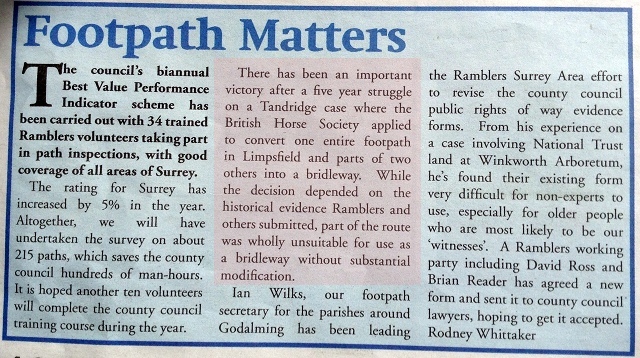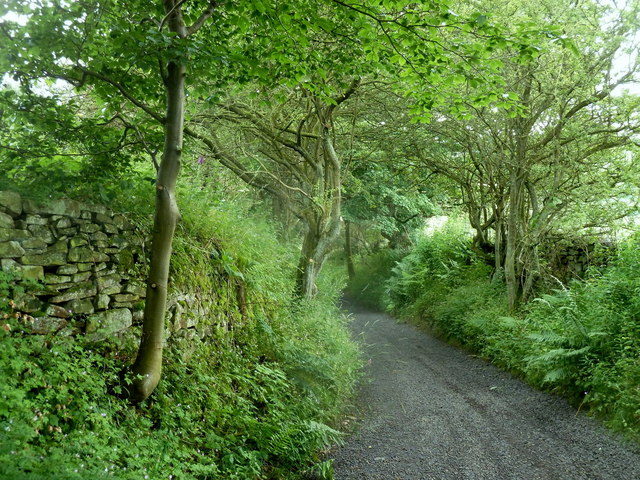Andrews 2 is a pending Court of Appeal case about the eligibility of public paths made under inclosure awards in the first half of the nineteenth century. Could Inclosure Commissioners, acting under local Acts incorporating the Inclosure Consolidation Act 1801, award public footpaths and bridleways over the old common lands being inclosed (as they appear to have thought), or are those paths null and void?
The question is not an academic one: quite the opposite. Hundreds of inclosures were made under powers incorporating the 1801 Act, and most of those do contain awarded public paths. Indeed, most inclosure awards, from the eighteenth century on to the early years of the twentieth century, did set out public paths. An award is a legally conclusive document made under an Act of Parliament, so a public path set out in the award is normally conclusive proof of its existence, even now perhaps two hundred or more years later — but uniquely those awarded under the 1801 Act are claimed to be fatally flawed.
A High Court decision in 1993, R v Secretary of State for the Environment, ex parte Andrews (“Andrews 1”), decided that the 1801 Act did not contain powers to award public paths (except in certain limited circumstances), and you can read more about it in my first blog on the case. This year, a fresh challenge (“Andrews 2”) was brought to revisit the same question, with the same claimant, John Andrews, represented by the same counsel, George Laurence QC, and judgment was again given against Mr Andrews by the High Court on 8 May: more about that in my second blog.
Both judgments are well reasoned and comprehensive. They both find that the following wording of s.10 of the 1801 Act:
“And be it further enacted, That such Commissioner or Commissioners shall, and he or they is and are hereby empowered and required to set out and appoint such private Roads, Bridleways, Footways, Ditches, Drains, Watercourses, Watering Places, Quarries, Bridges, Gates, Stiles, Mounds, Fences, Banks, Bounds and Land Marks, in, over, upon, and through or by the Sides of the Allotments to be made and set out in pursuance of such Act”
must be taken at face value — that ‘private’ qualifies the entire list of features which may be awarded, and that therefore only private bridleways and private footways were within the competence of the Commissioners. This blog looks at some of the extraordinary consequences of those decisions, in anticipation of an appeal to the Court of Appeal sometime next year.
In Andrews 1, the court noted that s.11 provided for the stopping up of any existing public rights of way across the common lands or fields which were being inclosed:
“all Roads, Ways, and Paths, over, through, and upon such Lands and Grounds which shall not be set out as aforesaid, shall for ever be stopped up and extinguished”
but decided that, as the 1801 Act did not enable replacement footpaths to be ‘set out as aforesaid’, then s.11 could not extinguish existing footpaths (and impliedly bridleways) across the inclosures.
This finding, which appears to be endorsed by Andrews 2 in the High Court, is remarkable. In the days before the widespread use of motorised transport, most people travelled by foot. Some — farmers, carriers, wealthy professionals and major landowners — kept horses, and had the option to travel by horse or by horse-drawn carriage. Most did not. People made mainly local journeys: from home to the village, to the market town, to the mill, to the pump or just to neighbouring villages, hamlets or farmsteads. And because, pre-inclosure, most of the surrounding lands were open commons, they tended to take the shortest route: the land was unenclosed, uncultivated and of poor quality, many of the local inhabitants would have had rights over the common (or at least, used the common), and there was no reason why the owner, the lord of the manor, would have had any interest in trying to stop such use, for to him it had little or no productive use. Commons then were rather like land surrounding African bush villages today: a complex web of desire lines. By way of example, when the Duke of Wellington obtained an inclosure award for Riseley Common (north-east Hampshire) in 1861, the award recited no fewer than 16 public rights of way which were to be stopped up across a relatively small common about two kilometres across (see the recital in the annexe here). Had Riseley Common been inclosed under the 1801 Act, it seems that most or all of the footpaths and bridleways contained in the recital would endure today.
Whereas in the Riseley Common example, the ways to be stopped up were specifically identified in the award, the same cannot be said of most awards made under the 1801 Act, because the inferred effect of s.11 was that all public ways were to be stopped up unless specifically set out anew, and nothing more need be said. That means that it is now difficult, up to two centuries later, to identify what public paths existed prior to inclosure which endure today. But the extraordinary effect of Andrews is that they do endure: whatever the impact on the allottee, however inconvenient to the cultivation of the land, regardless of the alignment relative to the boundaries of the new allotments. Since, without any other legal process, a highway in existence pre-inclosure is a highway now, it is unlikely that any of these public paths has ceased to exist. They are rarely if ever marked on the award maps, nor is any provision made in the award or on the map to preserve their alignment across the allotments, such as to ensure that stiles, gates or gaps were provided. It is impossible to avoid the conclusion that the parties to the inclosure awards did form the view, apparently wrongly, that the old public paths were stopped up, for they did nothing to record them or ensure their preservation. Yet legally, they were not stopped up, and the complex pattern of desire lines still survives, awaiting those who can demonstrate their existence from the sparse evidence available today. Ironically, the effect of Andrews is in theory to revive far more public paths in the countryside than were ever set out in inclosure awards.
In Andrews 1, the judge commented on a submission from Mr Laurence that:
“the scheme of the Act is that all rights of way, public and private, should appear in the award and be shown on the map and that anything not thus shown is extinguished. It is an attractive submission in the sense that, if correct, it would mean that there would be a clean start for the area and everyone would know where they stood.”
The judge concluded that Mr Laurence’s inviting ‘clean sheet’ proposition could not draw him away from his interpretation of section 11, and in any case, if a clean sheet was what the parties to an inclosure wanted in any particular case, they could include additional clauses to that effect in the local Act incorporating the 1801 Act. But the evidence seen by the court was that in most cases, the parties did not do that. We know from the evidence recited in the judgment that few local Acts took specific powers to award public paths, but the judgment does not record whether significant numbers of local Acts conferred powers to stop up public paths, to plug the loophole in s.11 of the 1801 Act. It seems very likely that they did not.
Of course, it is possible, as the courts have acknowledged, that surveyors implementing inclosures after 1801 either knew that the 1801 Act was defective and ignored the defect (perhaps the local Act was a fait accompli by the time they were appointed), or they were quite unaware of the defect. Either way, it is remarkable that no-one took any steps to address the problem, most notably that solicitors promoting inclosure Bills in Parliament did not at any time include appropriate additional clauses, even after many Bills had previously passed through Parliament and been put into effect.
That is not all. The judgments find that s.10 is incapable of sustaining an award of public paths. If that is so, s.10 is also incapable of sustaining an award of any public “Ditches, Drains, Watercourses, Watering Places, Quarries, Bridges, Gates, Stiles, Mounds, Fences, Banks, Bounds and Land Marks”. Any public feature so awarded, unless supported by an enabling clause in the local Act, must also be ultra vires. It may be hard to conceive of the relevance of ‘public…fences’, but awards of public watercourses, public watering places and public quarries (typically for use of the surveyor of highways in digging for roadstone) were commonplace. None of these awards was lawful. But if so, what happens to them: do the awarded features revert to the lord of the manor, and if so, why (the lord having been amply compensated in the award as put into effect)? Must the highway authority compensate the lord of the manor for past unlawful extraction from the quarry, or must it backfill what has been extracted? Who now owns and manages those public watercourses?
Finally, in Andrews 2, the court observed:
“The landowner of the farmland in Wiltshire that is the subject of the current case has been made the Second Interested Party to these proceedings and, not unnaturally, has expressed considerable concern that, if it succeeds and a public bridleway has to be created across his land where there has been no such bridleway before, considerable interference with (and loss of profitability of) his arable farming operations would result.”
The path selected for the challenge in this case appears to have been a pure example of one which relies entirely on an inclosure award (made under the 1801 Act) for its existence — i.e. there is no history of use or more recent historical evidence for it. That ensures that the court is not distracted by ‘irrelevant’ evidence: it can focus solely on whether the inclosure award was valid. But it also has the consequence that the claim for the path appears stark, for it would, if granted, give rise to a right of way across farm land where none has apparently been recognised for two centuries. In fact, the position is not quite so stark. For the most part, a defined track along most of the awarded alignment was certainly in use: it appears as a feature on the Ordnance Survey map appended to the judgment, which appears to be the first series twenty-five inch map from 1875, and continues to appear on maps up until the 1924 six-inch map (these maps can also be viewed at old-maps.co.uk). None of these maps shows the north-west portion of the bridleway, across a field to what is now the A429. But it does appear on the Ordnance Survey’s one-inch drawing, the working draft of the first one-inch map drawn in 1817, and now kindly made available online by the British Library, even if, by the time of the published one-inch map, the north-west portion had already been removed. Not so stark after all.



